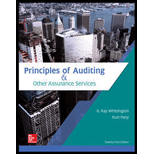
Describe the purpose and content of the major section of the audit plan.
Explanation of Solution
Audit planning:
Audit planning includes the designing of audit strategy for the organization, staffing, and conduct of the audit. Audit plan occupies the first step in the extensive
Purpose and content of the major section:
| Section | Purpose | Content |
| 1. Objectives of the engagement | To determine the requirements for the engagement. | a.) To audit the financial statements of the entity for the year ending on December 31, 2015, and b.) To prepare the report for entity’s debt agreement requiring compliance with different debt commitments. |
| 2. Business and industry condition | To identify the nature of the entity’s business and industry. |
a. The entity is engaged in selling, installing, and networking hardware and software services. b. The company is also providing consulting services for information technology. The company will have to monitor the competitive environment while keeping in view the projected annual growth of 3 per cent spending on information technology developments. |
| 3. Planning meetings | To disclose the meeting with the entity’s management team for engagement. | Two meetings held till date one with the president of the entity and the other with the engagement team to be assigned to audit. |
| 4. Ownership and management | To provide details about the management and owners of the company. | The company is closely held and owned by five stakeholders: TK, MK, JK, KY, and RY. Except for TK and MK who are the directors, no other owners are active in the management of the entity’s business. |
| 5. Objectives, strategies, and business risks | To describe the entity’s major strategies, business objectives, and risks associated with the achievement of such objectives. | Entities primary business objectives are to increase net income by 8 percent and revenues by 6 percent per year in consecutive three years. Major strategies are 1. Intense marketing of services and products by an increase in advertising. 2. To sell the products and services at higher credit risks. 3. Development of new software. The primary risks associated with business objectives are 1. Possible U.S. economy downturn 2. Predatory pricing risks by competitors to attain a large share in the market. 3. Desired results may not be achieved with increased advertising. 4. Increased losses due to high credit sales may override the increase in sales. 5. Development of software may not provide marketable products. |
| 6. Measurement and review of financial performance. | To recognize the method adopted as a performance monitor by the management. | Performance measurements are 1. Turnover of inventory and receivables. 2. Accounts receivable ageing. 3. Revenue in the form of gross margin and sales. 4. Net revenue. 5. Balance of inventory in total. |
| 7. Procedures to obtain an understanding of the client and its environment. | To elaborate on the procedures adopted to understand the client and the entity’s environment by the auditor. | The procedures are 1. prior-year's audit information review. 2. Inquires of management and reading board minutes. 3. Monthly performance report review. 4. Review of the entity’s website, reports from industry, and Wall Street Journal articles. |
| 8. Significant risks | To elaborate on the significant risks as recognized by the auditors. | Two significant risks include 1. The entity’s strategy to sell with higher credit risk. 2. The significant bonus issued to the officers on a quarterly basis. |
| 9. Significant auditing and accounting matters | To describe specific matters of auditing and accounting under concern. | Concerns include 1. Accurate accounting for extended warranties. 2. Software capitalization costs. 3. Possible software impairment. |
| 10. Materiality for planning | To recognize an amount to be spent on planning. | An amount of $300,000 to be spent for planning based on analysis of total assets, pre-tax net income, and sales. |
| 11. Scheduling and staffing plan | To submit the schedule for the engagement like portions of the audit and requirement for staffing. | As the interim audit work begins, the updated management letter is issued including major dates for scheduling and staffing plan. |
Table: (1)
Want to see more full solutions like this?
Chapter 6C Solutions
Principles Of Auditing & Other Assurance Services

 AccountingAccountingISBN:9781337272094Author:WARREN, Carl S., Reeve, James M., Duchac, Jonathan E.Publisher:Cengage Learning,
AccountingAccountingISBN:9781337272094Author:WARREN, Carl S., Reeve, James M., Duchac, Jonathan E.Publisher:Cengage Learning, Accounting Information SystemsAccountingISBN:9781337619202Author:Hall, James A.Publisher:Cengage Learning,
Accounting Information SystemsAccountingISBN:9781337619202Author:Hall, James A.Publisher:Cengage Learning, Horngren's Cost Accounting: A Managerial Emphasis...AccountingISBN:9780134475585Author:Srikant M. Datar, Madhav V. RajanPublisher:PEARSON
Horngren's Cost Accounting: A Managerial Emphasis...AccountingISBN:9780134475585Author:Srikant M. Datar, Madhav V. RajanPublisher:PEARSON Intermediate AccountingAccountingISBN:9781259722660Author:J. David Spiceland, Mark W. Nelson, Wayne M ThomasPublisher:McGraw-Hill Education
Intermediate AccountingAccountingISBN:9781259722660Author:J. David Spiceland, Mark W. Nelson, Wayne M ThomasPublisher:McGraw-Hill Education Financial and Managerial AccountingAccountingISBN:9781259726705Author:John J Wild, Ken W. Shaw, Barbara Chiappetta Fundamental Accounting PrinciplesPublisher:McGraw-Hill Education
Financial and Managerial AccountingAccountingISBN:9781259726705Author:John J Wild, Ken W. Shaw, Barbara Chiappetta Fundamental Accounting PrinciplesPublisher:McGraw-Hill Education





